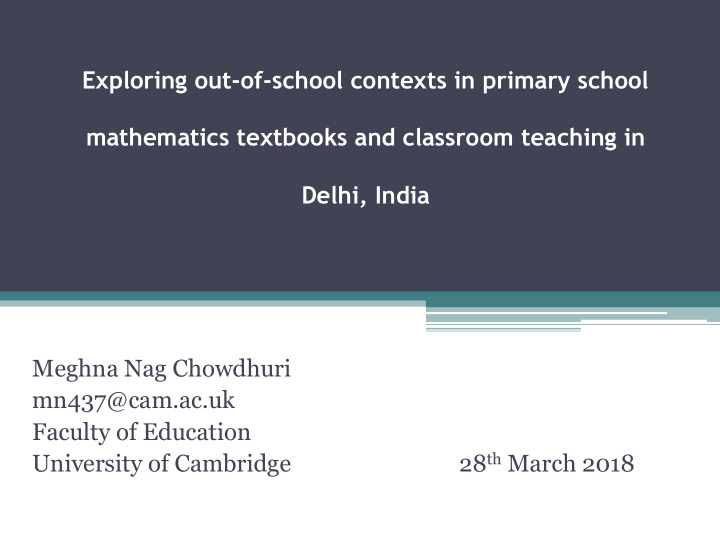



Exploring out-of-school contexts in primary school mathematics textbooks and classroom teaching in Delhi, India Meghna Nag Chowdhuri mn437@cam.ac.uk Faculty of Education 28 th March 2018 University of Cambridge
National Curriculum Framework 2005: Out-of-school context
Mathematics textbooks (Book 4 and 5) • Story based: Long or short • Contextual objects • Students’ everyday lives • Narratives • Social justice
Mathematics textbooks (Book 4 and 5)
Context: Stories Long story Short story
Context: Students lives
Context: Objects Schematised Illustrated
Context: Social justice Implicit: Gender representation Explicit: Caste discrimination
Classroom observations: Analysis
Students’ everyday lives T : Have you been to the bazaar with your mother to buy clothes? T : Then your mother must be saying that – give 1 m cloth or 2 m cloth. Does she? S : Ma’am some even measure saaris. It is 7 cm long. T : Yes, you get saaris measure too. T : How long should saaris be? S : Seven, six T : Yes, it should be 6. But how long do they turn out to be? S : Ma’am, five T : Yes, sometimes they turn out to be 5 as well. So will your mummy take such a saari ? S : No
Short story based T: Kajal has taken one apple for 2 rupees. okay? So how much will be 6 apples for? T: If one rope is for three rupees, then, four ropes will be for how much?
Contextual objects
Conclusion • Students experiences are being included in the classroom to an extent • Multiple representations • Contextual short stories are being used (Lubienski, 2002; Boaler, 1993) • Social justice is not being explicitly addressed (Gutstein, 2006)
THANK YOU!! mn437@cam.ac.uk
Recommend
More recommend